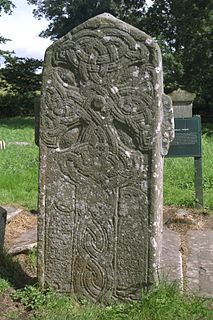Áed mac Néill, called Áed Findliath to distinguish him from his paternal grandfather Áed Oirdnide, was king of Ailech and High King of Ireland. He was also called Áed Olach according to Baile in Scáil, section 51. A member of the northern Uí Néill kindred of the Cenél nEógain, Áed was the son of Niall Caille.

The Kings of Ailech were the over-kings of the medieval Irish province of Ailech in north-western Ireland. It encompassed the territories of the Cenél nEógain and Cenél Conaill. After the battle of Cloítech in 789 its kings were exclusively from the Cenél nEógain. The royal fort for Ailech was the Grianan of Aileach, a hillfort on top of Greenan Mountain in modern-day County Donegal, Republic of Ireland.
Niall Glúndub mac Áedo was a 10th-century Irish king of the Cenél nEógain and High King of Ireland. Many Irish kin groups were members of the Uí Néill and traced their descent from Niall of the Nine Hostages.
Áed Allán was an 8th-century Irish king of Ailech and High King of Ireland. Áed Allán was the son of Fergal mac Máele Dúin and a member of the Cenél nEógain, a branch of the Northern Uí Néill.
Niall Frossach (718–778) was an 8th-century Irish king of Ailech, sometimes considered to have been High King of Ireland. Brother of high king Áed Allán, Niall was the son of high king Fergal mac Máele Dúin and a member of the Cenél nEógain, a branch of the Northern Uí Néill. The epithet Frossach (showery) is said to come from showers of silver, honey and wheat which fell on his home at Fahan in Inishowen at his birth.
Cathal mac Finguine was an Irish King of Munster or Cashel, and effectively High King of Ireland as well. He belonged to the Eóganacht Glendamnach sept of the dominant Eóganachta kin-group whose members dominated Munster from the 7th century to the 10th. His father, uncle, grandfather and great-grandfather had also been kings of Cashel, as were his son and grandson.
Fergal mac Máele Dúin was High King of Ireland. Fergal belonged to the Cenél nEógain sept of the northern Uí Néill. He was the son of Máel Dúin mac Máele Fithrich, a King of Ailech, and great grandson of the high king Áed Uaridnach. He belonged to the Cenél maic Ercae branch of the Cenél nEógain and was King of Ailech from 700 to 722.

Áed Uaridnach was an Irish king who was High King of Ireland. He is sometimes also known as Áed Allán, a name most commonly used for the 8th-century king of the same name, this Áed's great-great-grandson.
Cellach mac Máele Coba was an Irish king and is said to have been High King of Ireland.
Máel Dúin mac Áedo Bennán was a King of Iarmuman from the Eóganacht Locha Léin branch of the Eoganachta. He was the son of Áed Bennán mac Crimthainn, who may have been King of all Munster. His uncle Áed Dammán is called King of Iarmumu in his death obit giving Máel Dúin a possible reign of 633–661.
Máel Dúin mac Fergusa was King of South Brega of the Uí Chernaig sept of Lagore of the Síl nÁedo Sláine branch of the southern Ui Neill. He was the son of Fergus mac Fogartaig, a previous king of South Brega, and grandson of the high-king Fogartach mac Néill. He ruled from 778 to 785.
Máel Fithrich mac Áedo was a King of Ailech and head of the Cenél nEógain branch of the northern Uí Néill. He was the son of the high king of Ireland Áed Uaridnach. He ruled in Ailech from 628 to 630.
Máel Dúin mac Máele Fithrich was a King of Ailech and head of the Cenél nEógain branch of the northern Uí Néill. He had married Cacht ingen Cellaig, daughter of the high king Cellach mac Máele Coba of the Cenél Conaill and their son Fergal mac Máele Dúin was high king of Ireland.
Events from the 7th century in Ireland.
Ólchobar mac Duib-Indrecht was a supposed King of Munster from the Eóganacht Áine branch of the Eóganachta. His last paternal ancestor to hold the throne was Cúán mac Amalgado, five generations previous. His great-grandfather Uisnech had been the brother of another King Eterscél mac Máele Umai. According to a genealogical tract Uisneach was heir apparent to the Munster throne until slain by his brother through envy and hatred and then Eterscél assumed the kingship of Munster.
Iarmhumhain was a Kingdom in the early Christian period of Ireland in west Munster. Its ruling dynasty was related to the main ruling dynasty of Munster known as the Eóganachta. Its ruling branch was called the Eóganacht Locha Léin or Ui Chairpri Lúachra. Their center was around Killarney, County Kerry at Loch Léin. The name Iarluachair means west of the Sliabh Luachra mountains.
Congal mac Máele Dúin was a King of Iarmuman from the Eóganacht Locha Léin branch of the Eoganachta, the ruling dynasty of Munster. He was the son of Máel Dúin mac Áedo Bennán, previous king of Iarmuman and grandson of Áed Bennán mac Crimthainn, who may have been King of all Munster. He ruled from 661 to 690.
Máel Dúin mac Áedo Alláin was a King of Ailech and head of the Cenél nEógain branch of the northern Uí Néill. He was the son of Áed Allán, a high king of Ireland. He ruled from 770 to 788.
Murchad mac Máele Dúin was a King of Ailech and head of the Cenél nEógain branch of the northern Uí Néill. He was the son of Máel Dúin mac Áedo Alláin, a previous king and grandson of Áed Allán, a high king of Ireland. He ruled from 819–823.
Duinseach ingen Duach, Queen of Tara, fl. 500.
This page is based on this
Wikipedia article Text is available under the
CC BY-SA 4.0 license; additional terms may apply.
Images, videos and audio are available under their respective licenses.

